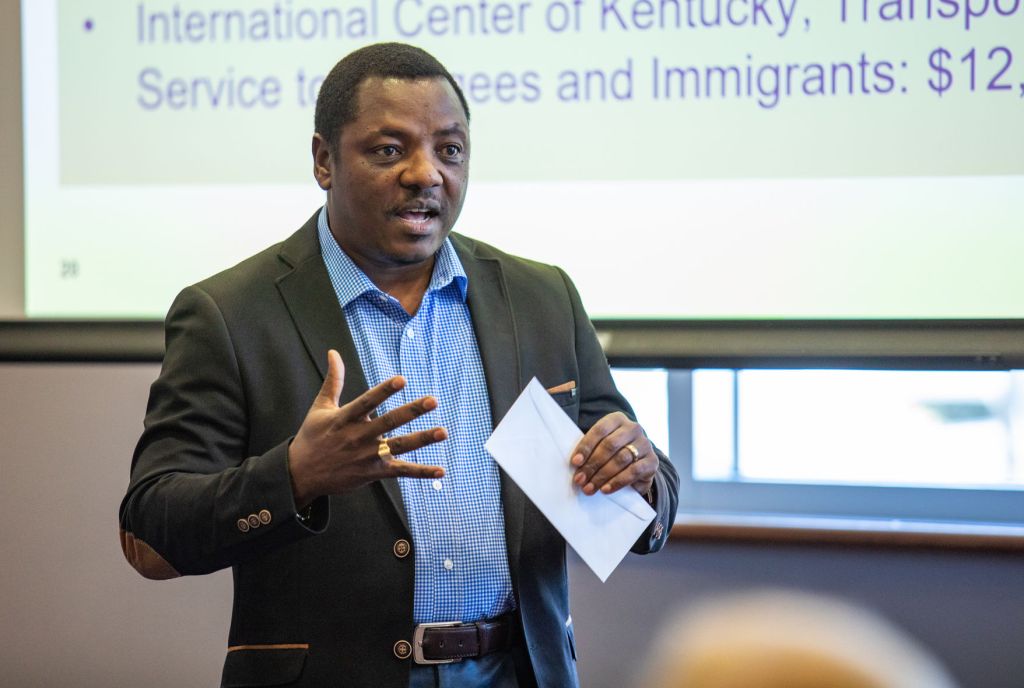Agencies propose 318 new refugees for Bowling Green
Published 6:00 am Saturday, July 27, 2024

- International Center of Kentucky Executive Director Albert Mbanfu accepts a United Way of Southern Kentucky grant on Wednesday, June 23, 2021. (Grace Ramey/photo@bgdailynews.com)
The local and state agencies responsible for refugee resettlement in Bowling Green have recommended that the federal government allocate 318 spots for refugees to resettle citywide this coming fiscal year – the same number as last year, according to the agencies.
On June 14, the International Center of Kentucky, one of the state’s resettlement agencies for refugees, consulted with local organizations affected by resettlement. The organizations included Warren County Public Schools, the Bowling Green Independent School District, the city of Bowling Green, Warren County, the Barren River District Health Department and the office of Rep. Brett Guthrie, R-Bowling Green.
The International Center of Kentucky proposed a higher number of refugee arrivals, while several of the local organizations wanted fewer, said Becky Jordan, Kentucky’s State Refugee Coordinator. So, she said, a suggestion came about to compromise with last year’s number.
Jordan put her support – which is required for submission – behind that number, which the International Center of Kentucky submitted to the region’s national resettlement agency, the U.S. Committee for Refugees and Immigrants. Jordan said that USCRI will discuss the number with the U.S. Department of State’s Bureau of Population, Refugees and Migration – the federal agency that holds the final say.
Albert Mbanfu, executive director of the International Center of Kentucky in Bowling Green, said he expects the bureau to announce a number by September. That’s the final month of the U.S. fiscal year – the deadline for when the Immigration and Nationality Act requires a president to sign the annual “Presidential Determination on Refugee Admissions,” a report that denotes the number of refugee admissions anticipated for the upcoming fiscal year.
Until the bureau’s announcement, it remains unclear how many refugees the U.S. will allow to resettle in Bowling Green.
Arriving refugees previously lived in refugee camps – often, for years. These facilities are temporary and built to provide swift protection and assistance to people forced to flee home due to war, violence or persecution, according to the U.N. Refugee Agency USA for UNHCR.
The camps intend to meet basic needs via shelter, medical treatment, water, food and other essential services. USA for UNHCR states that during long-term displacement, camps add “educational and livelihood opportunities as well as materials to build more permanent homes to help people rebuild their lives.”
But academic journals, international aid nonprofits and news publications have also long documented that occupants at these camps frequently experience dire circumstances such as widespread and severe hunger, dehydration and overcrowding.
USA for UNHCR states that the average period a refugee spends in a camp depends on the crisis. But it also notes that “in protracted refugee situations – where mass displacement has affected a country for five years or more – refugees may spend years and even decades living in camps, and it is common to have entire generations growing up in the camps.”
Concerning national politics, the International Center of Kentucky in 2017 expected a reduced number of refugee resettlements due to former President Donald Trump’s reduction of the resettlement cap, which a Congressional Research Service report documented as a drop from 110,000 refugees in 2016 to 50,000 in 2017. But this time, Mbanfu said, he doesn’t expect the presidential election to affect the number of resettlements.
This is because, although the average annual resettlement cap of President Joe Biden’s term would permit around 73,625 more refugees to arrive than the cap implemented under Trump’s presidential term, the U.S. (disregarding the remaining two months of the fiscal year) only resettled 11,747 more refugees over Biden’s term, according to data from the Migration Policy Institute, a nonpartisan research nonprofit.
Moreover, comparing the two periods, the International Center of Kentucky helped resettle more people in Bowling Green under Trump than Biden, Mbanfu said.
Arrivals Since Last October
Some 246 refugees arrived from the Oct. 1, 2023, start of the fiscal year through July 8 – mostly from Myanmar, Congo, Afghanistan and Guatemala, Mbanfu said.
Among the many reasons people have left their country and sought refugee status in Bowling Green over the past fiscal year, the most common has been civil war, Mbanfu added.
The center hasn’t yet crunched exactly how many children and adults have arrived over this past fiscal year. However, Mbanfu noted that there have been more children than adults, yet more working adults than school-aged children – indicating that a notable number of arriving refugees over the last year have been too young for school.
Trace Die Cast, Perdue Farms, Dollar General, Sodexo and Tyson Foods have been the biggest employers of refugees over this last fiscal year, Mbanfu said.
Daniel Tarnagda, executive director of the nonprofit Refuge BG, said the organization has a staffing agency to support refugees in job placement, and that the refugees he has worked with invest “so much time” into finding jobs and learning how employment works.
“As soon as those things are done, if they’re getting a job in Bowling Green, they’re going to be contributing tremendously to taxes to the community,” Tarnagda said.
Mbanfu added that the time refugees spend in living in refugee camps make them particularly determined, loyal employees.
“They’ve gone for years without an opportunity to work,” Mbanfu said. “(It’s) something they’ve dreamed of their entire time in the refugee camp but didn’t have the opportunity.”




